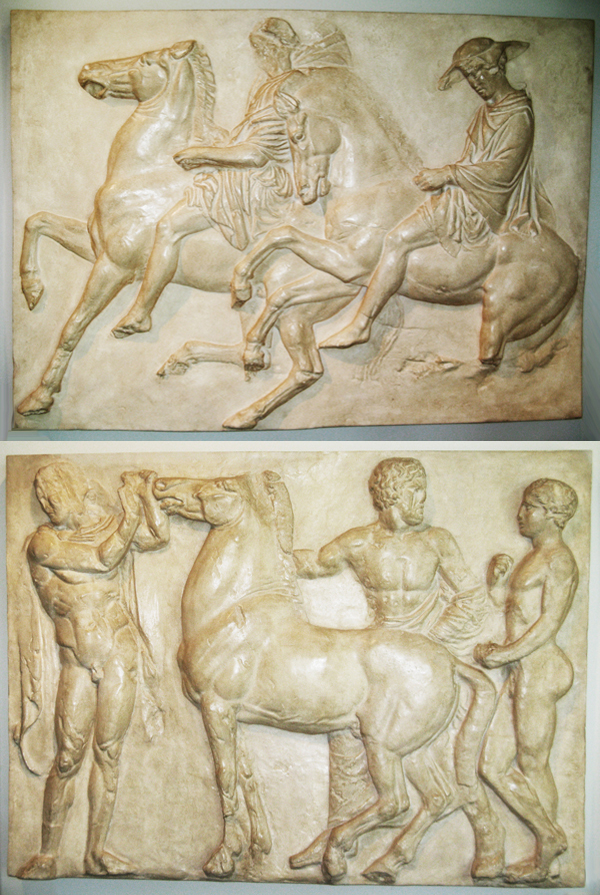Classical Greek Sculpture

Parthenon Frieze Panels
Classical Greek
replicas: from the Louvre, Paris
date of the original: c. 442-438 BC
provenance of the original: the Parthenon, the Acropolis, Athens; now in the New Acropolis Museum, Athens
description: Panels from the west frieze of the Parthenon depicting part of the Panathenaic procession held in honour of Athena every four years. Plaster replicas; Pentelic marble originals. Each: height 103 cm, width 141 cm, depth 13 cm.
Horsemen, One Wearing the Petasos (top)
Two horsemen astride, one wearing the hat called the petasos. Damage especially to head of lead horseman and back legs of rear horse.
This slab was until recently still in situ--that is, in the original spot on the western frieze of the Parthenon on the Acropolis of Athens. One of the horsemen wears a petasos, a wide brimmed hat. The damaged part above the head of the left rider was erroneously interpreted as the remains of a petasos. This slab as well as the one discussed below were part of the immense sculptural decor of the Parthenon, a temple which stood as the crowning achievement of Pericles’ building program. The sculpture of the Parthenon was supposedly executed after sketches of Pheidias. The designs, in themselves, were the task of a lifetime.
The Parthenon was the shrine of Athena Parthenos (the Maiden), and housed her lavishly decorated chryselephantine (gold and ivory) statue, which stood almost 12 m high. This statue is also attributed to Pheidias. No sculptor achieved such fame in the ancient world as Pheidias, while leaving practically no concrete proofs of his accomplishments; the great statue of Athena is long lost.
This slab of the frieze represents a scene from the Panathenaic procession which took place with special solemnity every four years in honour of Athena. Young aristocrats participated in it with a cavalcade of which the scene is part. There is a contrast between the rearing horses and the serene classical calm of their riders, who remain somewhat impassive in a dynamic action. Curiously, horses, also in later epochs, are generally overdone as fiery, mettlesome steeds, and so their anatomy is made rather “horsier” than it is in reality. Necks are mightier, legs daintier, etc. On the contrary, the riders’ drapery expresses, with simplicity, the movement and attitudes taken by the horsemen.
Stableman, Horse, Nobleman and Groom (bottom)
Three men attending a horse. Extensive damage to face of stableman. Probable artists: Ictinos or Callicrates under Pheidias.
The title could also be “Preparation for the Cavalcade”, which may be a more correct guess than the preceding pedantic identification. The well composed and structured group, a difficult task on a relief, as well as the well articulated bodies and poses, bear witness to the heightened skills, experience and sensitivity of Classicism. Nonetheless, the picture remains a living tableau. It is a frozen action, not yet thawed by naturalism.
(See also: "Mourning" Athena; Nike Loosening Her Sandal.)